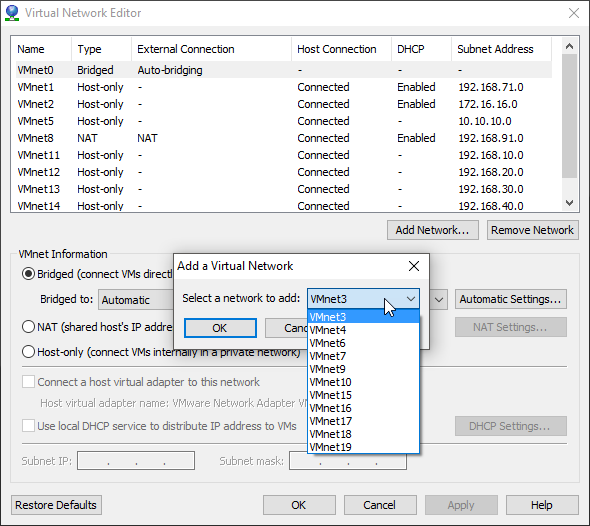


Configuring Virtual Network Adapter Advanced Settings.LAN segments are useful for multitier testing, network performance analysis, and situations where virtual machine isolation are important. When you select a LAN segment, the virtual machine uses a private network that can be shared with other virtual machines. When you configure host-only networking, Workstation Player creates a virtual private network (VPN) connection between the virtual machine and the host system.
VMWARE PLAYER NETWORK SETTINGS MAC
When you configure Network Address Translation (NAT), the virtual machine shares the IP address and MAC address of the host system.

Status Shows a summary of devices (connected/disconnected). Show Shows config/properties per interface (e.g. General Shows summary of connection (e.g. Verify the new settings have been applied via nmcli, and now you should be able to connect directly via your new IP (or via homeassistant.local:8123 which uses LLMNR to resolve hostname on Windows). Reload the settings, and toggle the interface. ‘ipv4.route-metric’ will be under section with field ‘route-metric=’. Once you see the options, you will need to ‘translate’ them. To find them, run the command nmcli connection show "Home Assistant OS default". Note: There are more options than above that you can modify. Then change the section below to match your needs. If the IP address in step 3 is incorrect, you can manually define a correct and persistent (survives reboots) static IP address which I would recommend.Ĭommand: vi /etc/NetworkManager/system-connections/default
VMWARE PLAYER NETWORK SETTINGS UPDATE
If it doesn’t update automatically, then usually that means some config is interfering but you can still manually disable/enable the interface via nmcli to force it. from bridged to NAT) and you should see this IP update automatically. Note: You can swap the VMWare network settings (e.g. enp2s1: connected to 'Home Assistant OS default' IP should be 192.168.1.55 if on subnet 192.168.1.0/24).Įxpected output: The interface enp2s1 is the VMware NIC interface. Verify that IP address of the attached VMware NIC is on the same subnet of your local network (e.g. If no entries can be found, verify that the docker containers exist.Įxpected output: You should see several container IDs of form homeassistant/MODULE Verify that the OS is listening for incoming connections to the webapp.Įxpected output: Some entry of the form 0.0.0.0:8123 or equivalent.Ģ.1. Upon booting the home assistant VM, and it automatically logging into the home assistant CLI, switch to the OS CLI via pressing ALT + F2. In my case, it turned out one of the randomly created Hyper-V adapters was handing out an IP to the home assistant VM which was on a completely different subnet than the bridged subnet. Disable all other virtual network adapters except the VMware virtual network adapters.Despite being an old topic, this is still relevant even today (2021), so I’m leaving some specific steps here to spare someone else the despair.


 0 kommentar(er)
0 kommentar(er)
